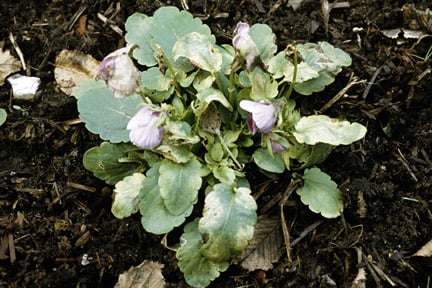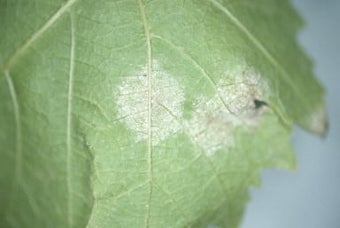
Quick facts
Common name - Pansy downy mildew
Scientific name - Peronospora megasperma
Plants affected - Viola spp. (pansies)
Main symptoms - Pale blotches and fuzzy grey growth on leaves
Caused by - Fungus-like (Oomycete) organism
Timing - Spring, particularly during cool, wet weather
What is downy mildew?
Downy mildew is a disease of pansies caused by the fungus-like organism Peronospora megasperma.
This fungus only attacks pansies, particularly winter-flowering types in cool, wet weather.
Symptoms
You may see the following symptoms:
- On leaves: Pale blotches on the upper leaf surfaces and corresponding patches of fuzzy grey growth on the underside. The margins of severely affected leaves may curl under, and these leaves often shrivel and die, sometimes becoming colonised by the grey mould fungus Botrytis cinerea
- On flowers: Severe infections lead to stunting and a reduction in the number of flowers
Pansies can also suffer from a number of leaf spot diseases, but the symptoms these produce are different from the pale blotches caused by downy mildew.

Control
Non-chemical control
- Remove infected leaves as soon as the discolouration on the upper surface is seen
- Do not allow infected leaves to contaminate the soil
- Do not grow pansies on the same site in consecutive years
Chemical control
No fungicides are available to gardeners to control pansy downy mildew. The fungicides available for other problems on ornamental plants, such as rusts and powdery mildews, are ineffective in controlling downy mildews.
Biology
The downy mildews are a large group of plant diseases caused by microscopic fungus-like (Oomycete) organisms related to the pathogen that causes tomato and potato blight. Despite a similar name and certain similarities in symptoms, they are unrelated to the powdery mildews. Pansies can also occasionally suffer from , although it is not usually as damaging to them as downy mildew.
Like other downy mildews, Peronospora megasperma is described as a biotroph; a pathogen that penetrates into host plant tissues over an extended period without killing them, while it extracts from the living host cells. During this period it releases airborne spores from the fuzzy fungus-like growth on the underside of leaves, which disperse to initiate new infections.
When the infected leaf tissues eventually die, it forms resting spores in the dead material which will then contaminate the soil. The pathogen can not grow in the absence of living plant cells.
There is little specific information on Peronospora megasperma, but it is likely that infections from resting spores are responsible for damage if pansies are replanted on sites previously affected. Infections are also caused by spores blowing in from other plants, possibly 1-2km (½-1 mile) away.
There is also a risk that commercially-raised plants may have been treated with fungicides, which suppress the symptoms but do not kill the pathogen, resulting in the disease breaking out after purchase when the effect of these fungicides eventually wears off.






